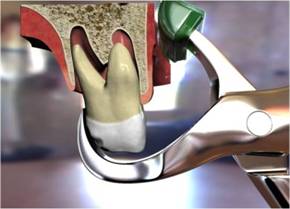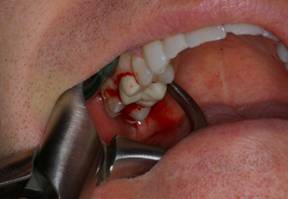Dental Extraction Forceps complement the biochemistry of tooth e
The general thought is that tooth extraction involves severing the periodontal ligament (PDL) in addition to expanding the socket, or alveolar bone. While this may be the basis of the traditional extraction technique, there is also an important biochemical response that must be considered. The trauma that occurs to the periodontal ligament during extraction with an elevator or forcep instrument causes the release of Hyaluronidase (Hyluronate Glycanohydrolase).
Hyaluronidase is the catalyst for the hydrolysis of hyaluronan (hyaluronic acid), a cementing substance vital to human tissue and the interstitial barrier. This, chemical breakdown by Hyaluronidase in the periodontal ligament is necessary for the release of the tooth from the alveolus attachment.
The Physics Forceps from Golden Dental Solutions is an instrument designed to complement this biochemical reaction. By placing consistent force to the periodontal ligament rather than the intermittent force applied by elevators or conventional oral surgery forceps, the Physics Forceps stimulates a more intense release of Hyaluronidase in a shortened time frame. Hence, this instrument achieves a more predictable, less traumatic result than the conventional extraction technique in which standard dental instruments are employed.
The Physics Forceps are based on the Class I lever. The patented beak and bumperâ„¢ design requires only slight wrist movement to achieve an Atraumatic removal. Using this instrument, you eliminate the need for pulling, pushing, rocking, twisting, and firmly grasping the tooth.
Acting like a Class I lever, the Physics Forceps beak act utilizes only one force against the lingual aspect of a tooth or its root. (even those that are rotted or bad). After the placement of the beak in this area, the bumper is situated against the alveolar ridge in the approximate area of the mucogingival juntion (below the gumline - not on the tooth) The placement of the bumper balances the beak. While the beak grasps the tooth, the bumper provides stability and leverage through which wrist and beak movement is maximized. 

Once the dental extraction forcep is in proper position, only wrist movement is necessary to apply pressure in a buccal direction. The gentle, steady application of pressure in the direction of the buccal should be done with the wrist until internal force, or the "creep," builds up. This force allows for the slow expansion of the bone and the subsequent release of the tooth from the periodontal pocket. This is known as the "pop." The successful buccal-only rotation technique requires only wrist rotation that is similar to the reverse-use of a bottle opener.
The technique employed by the Physics Forceps dental extraction instrument involves simply waiting for the natural biochemical reaction within periodontal tissue, making it more suitable for Atraumatic extractions when compared to conventional dental instruments and technique.
Reference:
Tooth Extraction: Biochemistry Using Dental Extraction Forceps. Frasher, J.R.E et al; Laurent, T.C.; Laurent, U.B.G. (1997) "Hyaluronan: its nature, distribution, functions and turnover" Journal of Internal Medicine 242: 27-33
Learn more about the Atraumatic extraction of teeth using the Physics Forceps when you visit www.physicsforceps.com or call 1-877-987-2284.
Golden Dental Solutions (formerly known as GoldenMisch).
Back to More Reading
Hyaluronidase is the catalyst for the hydrolysis of hyaluronan (hyaluronic acid), a cementing substance vital to human tissue and the interstitial barrier. This, chemical breakdown by Hyaluronidase in the periodontal ligament is necessary for the release of the tooth from the alveolus attachment.
The Physics Forceps from Golden Dental Solutions is an instrument designed to complement this biochemical reaction. By placing consistent force to the periodontal ligament rather than the intermittent force applied by elevators or conventional oral surgery forceps, the Physics Forceps stimulates a more intense release of Hyaluronidase in a shortened time frame. Hence, this instrument achieves a more predictable, less traumatic result than the conventional extraction technique in which standard dental instruments are employed.
The Physics Forceps are based on the Class I lever. The patented beak and bumperâ„¢ design requires only slight wrist movement to achieve an Atraumatic removal. Using this instrument, you eliminate the need for pulling, pushing, rocking, twisting, and firmly grasping the tooth.
Acting like a Class I lever, the Physics Forceps beak act utilizes only one force against the lingual aspect of a tooth or its root. (even those that are rotted or bad). After the placement of the beak in this area, the bumper is situated against the alveolar ridge in the approximate area of the mucogingival juntion (below the gumline - not on the tooth) The placement of the bumper balances the beak. While the beak grasps the tooth, the bumper provides stability and leverage through which wrist and beak movement is maximized.

Physics Forceps - Beak & Bumperâ„¢ Placement (animation) of
Dental Extraction Forceps
Dental Extraction Forceps

Physics Forceps - Beak & Bumperâ„¢ Placement of Dental Extraction Forceps
Provided by Dr. Ara Nazarian, DDS
After the proper placement of the dental extraction forcep, maximum leverage is obtained by loosely placing your hands or fingers toward the end of the instrument's handles. Squeezing is not necessary. Hold the forcep in a comfortable manner, using as many fingers as necessary to feel stable.Provided by Dr. Ara Nazarian, DDS
Once the dental extraction forcep is in proper position, only wrist movement is necessary to apply pressure in a buccal direction. The gentle, steady application of pressure in the direction of the buccal should be done with the wrist until internal force, or the "creep," builds up. This force allows for the slow expansion of the bone and the subsequent release of the tooth from the periodontal pocket. This is known as the "pop." The successful buccal-only rotation technique requires only wrist rotation that is similar to the reverse-use of a bottle opener.
The technique employed by the Physics Forceps dental extraction instrument involves simply waiting for the natural biochemical reaction within periodontal tissue, making it more suitable for Atraumatic extractions when compared to conventional dental instruments and technique.
Reference:
Tooth Extraction: Biochemistry Using Dental Extraction Forceps. Frasher, J.R.E et al; Laurent, T.C.; Laurent, U.B.G. (1997) "Hyaluronan: its nature, distribution, functions and turnover" Journal of Internal Medicine 242: 27-33
Learn more about the Atraumatic extraction of teeth using the Physics Forceps when you visit www.physicsforceps.com or call 1-877-987-2284.
Golden Dental Solutions (formerly known as GoldenMisch).
Back to More Reading
